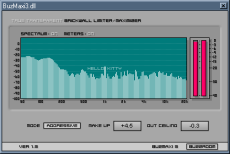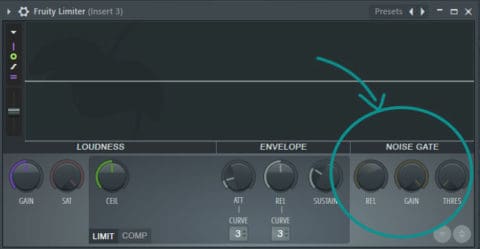

If the Thresh (threshold) control is turned entirely to the left (no threshold), the noise gate function is effectively switched off. What we will focus on is the basic noise gate functionality that it offers via the controls shown below: The Fruity Limiter is a compressor, limiter and noise gate in one. For simplicity’s sake, I use the master track here.

Note: It is better practice not to use the master track unless you want an effect to be applied to all sounds in your project (all sounds are routed to the master track). Go to the Mixer and add the Fruity Limiter to the first FX slot of the master track. Now, this is the unwanted noise that we will attempt to suppress using the Fruity Limiter. Make sure to listen to it a couple of times so you know what I am referring to. You will clearly hear a noise at the end of the sample (where you hear the word ‘yeah’). Next, place a few clips to the Playlist and play the song. To illustrate the Fruity Limiter noise gating capabilities, first add an Audio clip to the Step Sequencer and load the FLS_OhYeah.wav sample, which you find in your FL Studio folder under Data\Patches\Packs\Vocals. But also the fruity Love Philter can be used for this purpose. In FL Studio you have a few options when it comes to noise gates, most notably the Fruity Limiter. How fast it closes, depends on the release setting.

Similarly, when the input signal falls below the threshold value, the gate closes. How fast it opens depends on the attack setting. When the input signal exceeds the threshold, the noise gate opens. As long as it is below the threshold value (the gray line), the noise gate is closed (see the green line for the output signal). The red line represents the input signal. If the sound is below the threshold, the sound is not let through (the noise gate is closed). Simply put, a noise gate allows a sound to pass when it is above a certain threshold (the noise gate is open). The purpose is not to remove the noise from the sound (once noise is part of a sound it is hard to remove it), but rather to hide it during quiet sections where the track would otherwise only contribute with unnecessary noise. The accumulated noise can go well beyond the audible and turn your mix into a muddy, blurred blend.īy utilizing so called noise gates, we can manage the noise on a track. Even if you do not or hardly notice the little bit of noise in your sounds, it is simply good practice to remove it as the problem is quickly magnified when dealing with multiple tracks. Hiding background noise from sounds and samples is an important step towards a clean, crisp sounding mix. FL Studio tutorial explaining how to hide noise.


 0 kommentar(er)
0 kommentar(er)
